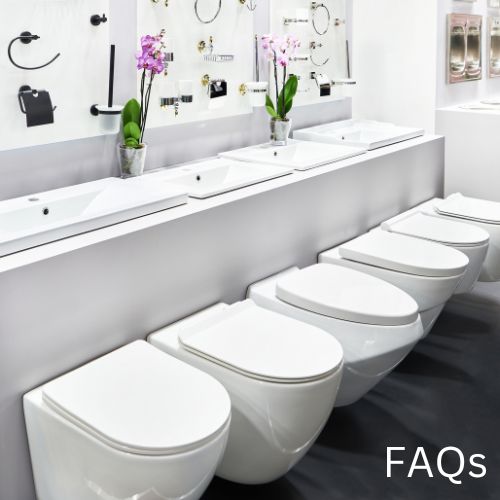Choosing the right toilet involves balancing functionality, design, and water efficiency. It’s not just about finding a model that looks good in your bathroom but also one that aligns with your needs regarding comfort, flushing technology, and water conservation.
With options ranging from different heights and bowl shapes to advanced features like bidet functions and smart capabilities, there is a type of toilet for everyone.
Opting for water-saving models can also lower your bills and benefit the environment. Ultimately, thorough research and comparing performance and reviews will help you select a toilet that best suits your preferences and lifestyle.
Table of Contents
How to Choose a Toilet For Your Home
When selecting a toilet, consider efficiency, space, and design. Here are the most popular toilet choices in 2024:
One-Piece vs. Two-Piece Toilets
One-piece toilets offer an integrated tank and bowl, eliminating the crevice between the tank and bowl that can harbor bacteria. They tend to have a higher price point but are easier to clean and have a sleeker appearance. On the other hand, two-piece toilets have a separate bowl and tank, which can be easier to handle during installation. They are often more cost-effective and standard in design, making them a common choice for many households.
Our blog post on one-piece vs two-piece toilets explores this further.
Wall-Mounted Toilets
Wall-hung toilets provide a modern look and save space in your bathroom. They are mounted to the wall, with the tank usually concealed behind it, offering easy cleaning beneath the unit. Installation can be more complex, requiring a sturdy wall carrier to support the weight and the services of a professional plumber.
High-Efficiency Toilets and Water Conservation
High-efficiency toilets (HETs) like dual-flush and low-flow models save significant water compared to traditional toilets. They use less than 1.28 gallons per flush, aligning with the Environmental Protection Agency’s WaterSense standards. By choosing a high-efficiency toilet, you’re reducing your water bill and contributing to environmental protection through water conservation.
If you’re undecided, this blog post on dual flush vs single flush toilets may help.
Choosing the Right Size and Shape
Selecting your toilet’s correct size and shape ensures a comfortable fit for your bathroom space and personal use. Key factors include the rough-in distance, bowl shape, and seat height.
Toilet Size and Rough-In Distance
The rough-in distance is the space between the wall behind the toilet and the center of the drainpipe or bolts that hold the toilet to the floor. Most toilets have a rough-in distance of 12 inches, but it can be 10 or 14 inches for some models. Measure this distance accurately to ensure the toilet you choose fits properly in your bathroom.
Round vs. Elongated Bowls
Toilet bowls are generally available in two shapes: round and elongated. Round bowls are space-saving, making them suitable for smaller bathrooms. On the other hand, elongated toilet bowls are typically 2 inches longer, providing additional comfort and are often considered more aesthetically pleasing.
Comfort Height Toilets
Comfort height toilets, also known as chair height toilets, are taller than standard toilets, with seats 17 to 19 inches from the floor compared to the standard 15 inches. These toilets can be especially beneficial for taller individuals or those with mobility issues, granting ease of use with a height similar to a regular chair.
Flush Options for Your New Toilet
When you’re selecting a new toilet, the effectiveness of the toilet’s flushing system is crucial to prevent clogs and ensure waste is efficiently transported to the sewer. The flush your toilet employs can impact its flushing performance, water usage, and maintenance requirements.
Gravity Flush Mechanisms
Gravity flush systems are the most common and use the weight of the water in the tank to create a flush. When you press the handle, the flapper lifts, allowing water to rush from the tank into the bowl through the flush valve. This flushing mechanism is known for being quiet and requiring less maintenance due to fewer mechanical parts.
Pressure-Assisted Flushing
Pressure-assisted toilets use pressurized air to force water into the bowl, which can be more effective at preventing clogs. These toilets have a pressure tank that works like a big water balloon. Water fills the toilet tank and is held under pressure. When flushed, the pressurized water is forced out, giving a more powerful flush better at clearing solid waste. However, these flushes are louder and may have a higher upfront cost.
Dual-Flush Technology
Dual-flush toilets have two options for flushing: one for liquid waste and another for solid waste. The dual flush system is designed to save water and is identified with a Map score that indicates flushing performance efficiency. A higher Map score means better waste removal per flush. Dual flush technology allows you to choose from a partial flush for liquid waste or a full flush for solids, which can significantly reduce your household’s water usage over time.
Full flushes can use up to 1.6 gallons per flush (GPF), whereas half flushes can use as little as 0.9 gallons per flush.
Types of Toilet Seats and New Release Features
When selecting a new toilet, beyond basic functionality, there are advanced features that can enhance your comfort and hygiene.
Heated and Bidet Seats
Bidets offer a gentle and effective way of cleaning yourself after using the toilet. Models with bidet functions can either be a separate fixture or integrated into the toilet seat. Heated seats provide added comfort, especially in colder climates, ensuring a warm seat during every use.
Innovative Toilet Seat Designs
Innovative toilet seat designs can significantly impact your bathroom experience. Look for soft-close hinges to prevent slamming or seats with a washlet function, which includes integrated bidet and drying features for maximum hygiene and convenience.
Built-In Deodorizers and Cleaning Technology
Some toilet models have built-in deodorizers that neutralize odors, creating a more pleasant environment. Look for models with the WaterSense label for water efficiency. Newer toilets come with advanced cleaning technology, such as self-cleaning systems, smooth-coated bowls, and trapways that reduce the need for manual toilet bowl cleaners, keeping the bowl clean with little effort on your part.
Replacing a Toilet
When you buy a new toilet, you should get it installed by a plumber. But DIY toilet installation isn’t uncommon, especially if you are replacing your existing toilet with a similar model. Here is what you may need, depending on the toilet you choose.
Tools and Fittings Needed
To install a toilet, ensure you have the necessary tools and fittings on hand. The basic items you’ll need include:
- Adjustable wrench to tighten and loosen nuts and bolts.
- Screwdriver for securing the toilet and tank to the floor and wall.
- Level to ensure the toilet is perfectly horizontal.
- Hacksaw for cutting bolts to size.
- Plunger to clear the drain before installation.
- Utility knife for trimming the wax ring and gaskets.
For fittings, you will need a wax ring to seal the connection between the bottom of the toilet and the drainpipe, ensuring a watertight seal. Depending on your bathroom setup and the model chosen, additional fittings like bolts and washers, a toilet seat, and supply lines may also be necessary.
We recommend hiring a plumber if you are renovating your bathroom and moving plumbing fixtures and fittings.
Professional vs. DIY Installation
Deciding between professional and DIY installation can depend on your comfort level and experience. A DIY installation can save you money if you’re adept with home improvement tasks. However, if you’re installing in a new build or dealing with a brand like Delta, following their specific instructions is essential for maintaining the warranty and ensuring proper function.
A professional installation guarantees that your new toilet is set up correctly, aligning with local codes and standards. Remember, incorrect installation can lead to leaks and costly water damage, so weigh your decision carefully.
Frequently Asked Questions

When you’re in the market for a new toilet, you may have questions about brands, cost, efficiency, important features, and even color trends for 2024. This section aims to answer some of the most common queries to guide your purchase.
What are the best brands of toilets in the US?
In the US, reputable toilet brands are known for their quality and durability. Brands like Kohler, American Standard, and Toto frequently receive high marks for their performance. A best toilet buying guide from Consumer Reports can offer additional insights into top-rated brands.
How much should I pay for a good toilet?
The price of a good toilet can vary, typically from $500 to $900, and into the thousands for smart toilets. Knowing that a higher price only sometimes equates to better performance is important. Your focus should be finding a toilet that offers both efficiency and comfort within your budget.
How much should I pay for a good toilet?
The price of a good toilet can vary, typically from $500 to $900, and into the thousands for smart toilets. Knowing that a higher price only sometimes equates to better performance is important. Your focus should be finding a toilet that offers both efficiency and comfort within your budget.
What is a high efficient toilet?
A high efficient toilet, or HET, is designed to use significantly less water per flush compared to standard models to conserve water. These toilets often bear the WaterSense® label, indicating compliance with EPA criteria. These labels mark toilets that can reduce water bills and are better for the environment.
What is the most important part of a toilet?
The most important part of a toilet is the flush mechanism. It’s the core of the toilet’s functionality and is responsible for its flushing power and water efficiency. No matter the design or feature set, the toilet’s performance will be compromised without a reliable flush mechanism.
What is the most popular color of toilets in 2024?
While white remains a classic and popular choice for toilets, the trend for 2024 is seeing a rise in shades of gray and off-white tones. These colors offer a modern twist and can easily fit into the aesthetic of contemporary bathrooms. Black toilets are also on the rise.
Final Considerations
When selecting a toilet, consider the key features that align with your needs and preferences. These include:
- Toilet Seat: Choose a seat that suits your comfort level, whether cushioned, heated, or a standard design.
- Function: Assess the flushing system for efficiency. A dual-flush option can offer you the versatility to use less water for liquid waste.
- Weight and Build: Aim for a design that complements your contemporary bathroom without compromising functionality.
- Water Usage: Look for models certified by the Environmental Protection Agency’s WaterSense program to ensure water efficiency.
- Environmental Protection: By choosing toilets with lower water consumption, you contribute to water conservation.
Remember the internal components:
| Feature | Importance |
|---|---|
| Trapway | A larger trapway diameter can reduce clogging. |
| Flushing System | The efficiency determines water usage and cleanliness. |
Selecting the ideal toilet for your bathroom is a thoughtful process that extends beyond aesthetics to include practical considerations such as efficiency, comfort, and technology. By carefully evaluating your needs against the variety of options available you can make an informed decision.
Whether you prioritize sustainability, comfort, or innovation, the key lies in finding a high-performance toilet that aligns with both your lifestyle and environmental values, ensuring your choice is as smart as it is stylish.
